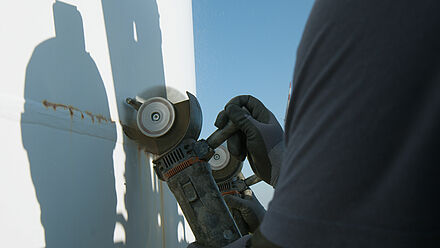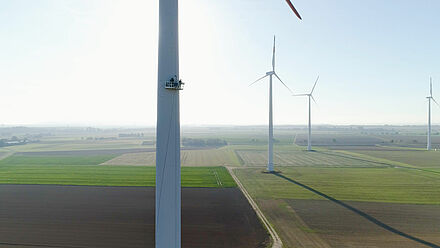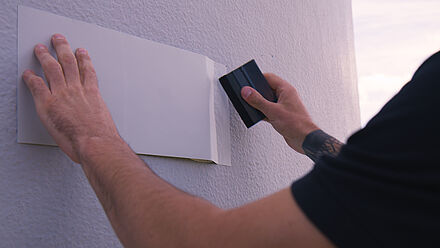[RENOLIT] CP
Long-Term Corrosion Protection for Wind Turbines
RENOLIT CP corrosion protection film offers reliable and long-term protection for steel and metal coatings on wind turbine towers. The new coating concept enables faster and more flexible repairs as well as being environmentally friendly and durable.
The corrosion protection film for the wind energy industry is the first product of a new portfolio developed by RENOLIT and now distributed in cooperation with WP Energy (part of the WP Group). WP Energy is a provider of inspection, repair and maintenance services with a focus on onshore and offshore wind energy.

Benefits and Functions
Ease of repairs planning
Repairs can be flexibly planned due to the film’s simple application process, independence of weather conditions during application and the rapid drying time of the primer.
Low dependence on weather conditions
Application of the film is less weather-dependent than painted coatings. Temperature fluctuations or precipitation shortly after application are unproblematic.
Short drying times
As only primer and the film need to be applied but no multiple paint coatings, drying and finishing times are short.
Fewer application steps
The coating process only requires a few steps: After the surface has been cleaned and primer has been applied, the film can be applied.
Low maintenance
Due to its outstanding durability of 10 years, film maintenance costs are kept to a minimum.
Constant film thickness
The film has a constant thickness of 160 µm (microns) and thus offers a smooth and even surface.
Little adherence of dirt and moss
The film forms a homogeneous surface which effectively resists the adherence of dirt particles or moss.
Minimum downtime
Rapid application, low maintenance and the long durability of the film ensure that wind turbines stay in operation for longer (less down-time).
Environmentally friendly
The film is environmentally friendly: Application of the film neither releases any volatile organic compounds (VOC) nor creates any special (problematic) waste. This eliminates hazards to people and the environment as well as health risks.
Flexible
The film is flexible and can even be applied on complex geometries.
Application project: The [RENOLIT] CP corrosion protection film has proven itself once again

The RENOLIT CP high-performance film has once again proven itself in a practical project: Repair work was planned for two wind turbine towers at a wind farm near Hannover, Germany. Severe corrosion on the flange areas and weld seams had brought the experts from WP Energy to the field: they applied around 45 square meters of the protective film, thus renewing the legal corrosion protection requirement for wind turbines.
First pilot project started: The [RENOLIT] CP corrosion protection film undergoes practical trials
The first pilot project with the RENOLIT CP corrosion protection film was stared at a wind farm near to Cologne (Germany) in September 2020. Approximately 33 square meters of the new corrosion protection film for onshore wind turbines was applied to the towers of two turbines from a renowned manufacturer. This trial should test the film against other coating methods and be routinely inspected.

Contact us for more information
Download
Blog articles
FAQ
You probably have some questions about the new film. In the following, we have collected a number of technical details and questions along with their answers. In case you have queries which are not mentioned here, please do not hesitate to contact us!
Questions about corrosion in general
What causes corrosion?
Corrosion is defined as the gradual destruction of materials by chemical or electrochemical reactions with their environment. These interactions result in alterations to the characteristics of the metal. Metals are only found in nature in the form of ores. To transform these ores into a usable material, a conversion process is used to extract oxygen. When metals come into contact with oxygen they corrode to revert back to their original oxidized state.
Which corrosion classifications available?
There are a total of six corrosion categories. They are categorized based on the location of the structures and the prevalent local corrosion potential.
- C1 = Minor: Heated buildings, reduction in the thickness of unalloyed steel ≤ 1.3 µm (microns)
- C2 = Low: Atmospheres with little pollution as well as unheated buildings with condensation; reduction in the thickness of unalloyed steel > 1.3 – 25 µm
- C3 = Moderate: Urban and industrial atmospheres with low SO2 pollution, low-salt coastal atmospheres as well as production areas with high humidity levels; reduction in the thickness of unalloyed steel > 25 – 50 µm
- C4 = High: Industrial atmospheres and coastal atmospheres with moderate salt levels; reduction in the thickness of unalloyed steel > 50 – 80 µm
- C5 = Very high: Industrial areas with high levels of humidity and aggressive atmospheres, coastal atmospheres with high salt levels; buildings or areas with almost permanent condensation and heavy pollution; reduction in the thickness of unalloyed steel > 80 – 200 µm
CX = Extreme: Offshore locations with high salt levels, industrial areas with extreme humidity and aggressive, sub-tropical or tropical atmospheres; industrial areas with extreme humidity and aggressive atmospheres; reduction in the thickness of unalloyed steel > 200 – 700 µm
What damage is caused by corrosion?
Corrosion can affect the strength of steel structures which can lead to downtimes and significant financial losses.
How to protect against corrosion?
To protect steel and metal coatings against corrosion, a number of corrosion prevention systems can be used. Such systems normally use two or more corrosion protection coatings which, depending on the location of the structure, can differ in function and coating thickness.
Questions about the [RENOLIT] CP film
Which material is the film made of?
The film is made of PVC.
Is the film certified?
Yes, the RENOLIT CP film is certified according to ISO 12944-9 CX (protection duration: High) and provides long-term corrosion protection of 10 years.
CX represents the highest corrosion category. This means that the film protects steel and metal coatings in locations in which the risk of corrosion is extremely high. These include industrial areas with high humidity levels, high salt levels and especially aggressive atmospheric conditions.
Is the film UV resistant?
Yes, the film is UV resistant (ISO 4892-2).
How thick is the film?
The thickness of the film itself is 160 μm (microns). Together with the adhesive, the overall thickness of the film is ≥ 230 μm (microns).
What colour is the film?
The standard colour of the film is RAL 7035 (light gray). The film is also available in other colors upon request.
How resistant is the film against temperature fluctuations? At what temperatures can the film be applied?
The applied film can withstand temperatures of between -30 and 70 °C.
The film can be applied at temperatures of between 10 and 35 °C.
Questions about the film’s application
How does the application work?
First of all, all old paint and rust must be removed and the substrate is thoroughly cleaned. A zinc primer is then applied to protect against renewed corrosion. The zinc acts as a sacrificial anode and thus combats the oxidation of the steel.
Finally, the RENOLIT CP film is applied (bubble-free) with a squeegee.
How long does it take for a wind turbine to be in operation again after it has been applied with film?
Wind turbines are ready for operation directly after the application process has been completed.
Who can apply the film? And do they require specific training?
Yes. The film can be easily and rapidly applied after the application personnel have undergone training or instruction.
News
Your contact person

Marek Stawinski
Key Account Management
| Mobile: | +49.172.307.9317 |
| Email: | marek.stawinski@wp-energy.de |
| Address: |
WP ENERGY GmbH Member of the WP Group Böcklerallee 3 D-27721 Ritterhude |










